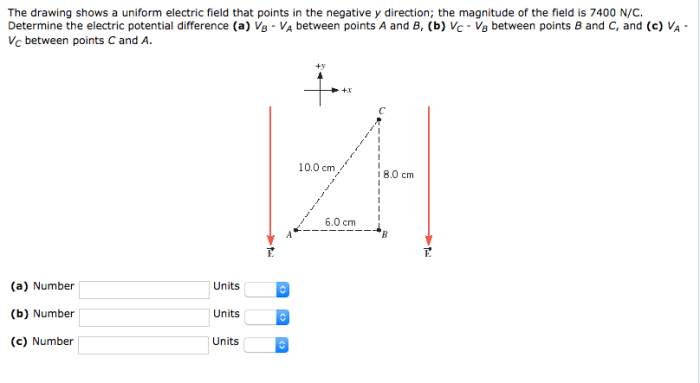The drawing shows a uniform electric field that points, a fundamental concept in electromagnetism, providing a visual representation of the invisible forces that govern the behavior of charged particles. This guide delves into the intricacies of uniform electric fields, exploring their properties, applications, and significance in various scientific disciplines.
Delving into the basics of electric fields, we elucidate their nature and characteristics, setting the stage for a comprehensive understanding of uniform electric fields. The discussion encompasses the significance of field lines and equipotential surfaces, providing a deeper insight into the behavior of electric fields.
1. Electric Field Basics

An electric field is a region of space around a charged particle or object where other charged particles experience a force due to the presence of the first particle or object.
A uniform electric field is a special type of electric field where the electric field strength is the same at every point in space. The electric field strength is a vector quantity that has both magnitude and direction.
The direction of the electric field is the direction in which a positive test charge would experience a force. The magnitude of the electric field is the amount of force that a positive test charge would experience per unit charge.
The drawing below shows a uniform electric field that points to the right. The electric field strength is represented by the length of the arrows. The longer the arrow, the stronger the electric field.

2. Drawing a Uniform Electric Field

To draw a uniform electric field, draw a series of arrows that point in the same direction. The length of the arrows should be proportional to the strength of the electric field.
The direction of the arrows should indicate the direction in which a positive test charge would experience a force. The magnitude of the electric field is the amount of force that a positive test charge would experience per unit charge.
The following figure shows three different orientations of a uniform electric field.

3. Field Lines and Equipotential Surfaces

Field lines are lines that are drawn to represent the direction of the electric field at every point in space. Equipotential surfaces are surfaces where the electric potential is the same at every point.
In a uniform electric field, the field lines are parallel and evenly spaced. The equipotential surfaces are planes that are perpendicular to the field lines.
The following table summarizes the characteristics of field lines and equipotential surfaces.
| Characteristic | Field Lines | Equipotential Surfaces |
|---|---|---|
| Direction | Tangent to the electric field at every point | Perpendicular to the electric field at every point |
| Spacing | Evenly spaced | Not evenly spaced |
| Shape | Straight lines | Planes |
4. Applications of Uniform Electric Fields

Uniform electric fields are used in a variety of applications, including:
- Electrostatic precipitators
- Inkjet printers
- Electron microscopes
- Accelerators
Electrostatic precipitators use a uniform electric field to remove dust and other particles from the air. Inkjet printers use a uniform electric field to control the flow of ink droplets. Electron microscopes use a uniform electric field to focus a beam of electrons.
Accelerators use a uniform electric field to accelerate charged particles.
The following is a simple experiment that demonstrates the effects of a uniform electric field.
Experiment:, The drawing shows a uniform electric field that points
Suspend a small piece of paper from a thread. Bring a charged object near the paper. The paper will be attracted to the charged object.
This experiment demonstrates that a charged object creates a uniform electric field around itself. The paper is attracted to the charged object because it experiences a force due to the electric field.
Question Bank: The Drawing Shows A Uniform Electric Field That Points
What is the significance of the arrow’s direction and length in a uniform electric field?
The direction of the arrow indicates the direction of the electric field, while its length represents the strength of the field.
How do field lines and equipotential surfaces relate to a uniform electric field?
Field lines are imaginary lines that indicate the direction of the electric field at each point, while equipotential surfaces are surfaces where the electric potential is constant.